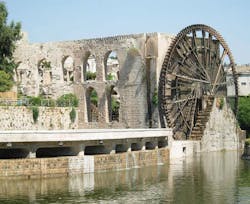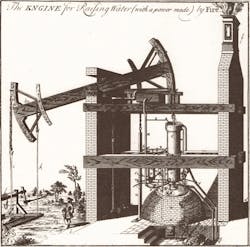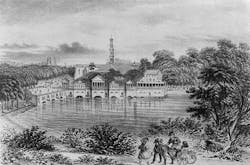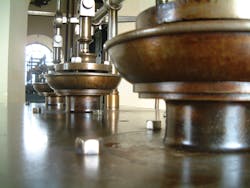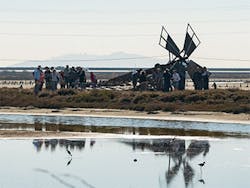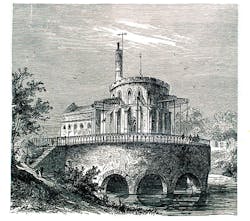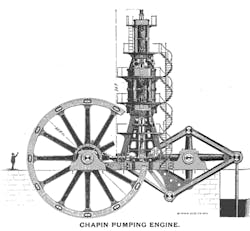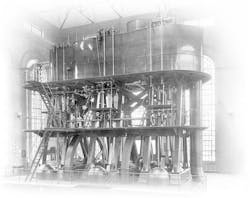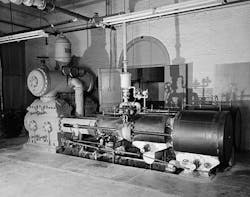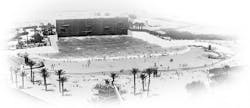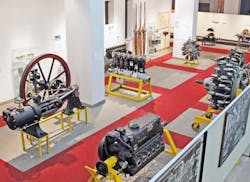A History of Landmark Pumps and Waterworks: ASME Milestones
Few pieces of machinery are as widespread and critical as pumps. They help move and lift liquids, chiefly water, which all modern cities need to survive. They also move waste, flood waters, and sewage, also necessities for modern life. All of these pumps and pumping facilities were chosen by the American Society of Mechanical Engineers as Landmarks of Mechanical Engineering.
Noria at al-Muhammadiyva (1361)
This ancient water wheel is one of many used in what was ancient Syria. The Syrians used water power to power the wheel as it lifted pots of river water up to an aqueduct. Noria translates as “the wailer,” and they got this name from the sound their wooden bearings made when the norias were turning. But this wooden water wheel was one of the largest, measuring 69 ft. tall. Most norias were only about 8 ft. tall. It lifted water up to an aqueduct that fed the al-A’la Mosque and its surrounding gardens, the public bath of Hammam as-Dahab, and houses and fountains in the neighborhood. Fourteen of the arches that supported the aqueduct still stand, and the noria still turns, lifting water up into them—but only because the noria was restored in 1977 as a historical tourist attraction. Hopefully, it survived the current unrest in Syria.
Newcomen Steam Engine (1712)
Removing water from coal mines and other mining operations was a major stumbling block in the early 1700s. Up until then, when a mine got too deep, it was constantly flooded and therefore abandoned. Early engineers experimented with steam but had little luck, until Thomas Newcomen came along. He developed an engine which used a vacuum created by condensing steam from a pressure just above atmospheric. A vertical open-topped cylinder held a moving piston which was connected by chains to one end of a massive rocking beam. Pump rods that went down into the mine were attached to the beam’s other end. Steam sent into the cylinder from a boiler below the cylinder, together with the weight of the rods, moved the piston towards the top of the cylinder. Then water sprayed inside the cylinder created a vacuum which pulled the piston down, rocking the beam and creating a stroke.
The design was incredibly successful and helped miners bring out the coal that fueled the Industrial Revolution. It remained the state-of-the-art in large pumps for 64 years and was used all across Europe. It even made it to the New World (That’s when James Watt developed the separate condenser and closed the top of the cylinder.)
Fairmount Water Works (1815)
Some forward-thinking city fathers in Philadelphia had the idea to use steam pumps to help supply their city with fresh water from the Schuykill River. By 1815 the Fairmount Water Works was up and running, sending water through wooden mains to much of the city. Two steam engines—one a Boulton Watt type—lifted water up from the river and into the main, the first steam-driven pumping system in the U.S. Two years later both engines were replaced by a larger, more capable engine that used steam at 200 psi. It could pump more than three million gallons of water a day, a great improvement. But it cost $30,000 a year to keep the pump operating, and the water service only took in $20,000 annually. The engine also exploded twice, killing three men.
In 1822, the pumps, as well as the wooden mains, were replaced by water wheels powered by the river and mill races along with cast iron pipes. All of these mechanisms were installed in the Classic Greek Revival building of the Fairmount Water Works.
A Museum of Cornish Beam Engines (1820)
The Brits have tuned the Kew Bridge Waterworks, which operated from 1820 to 1869, into a rare display of five Cornish Beam steam engines still housed in one of the places they were put to work. The five engines include a 100-in. diameter version, as well as a 90-in. diameter one that is still operational. The museum also holds a variety of Victorian engineering marvels, including vertical rotative and horizontal compound pumps, as well as diesel and electric pumps.
Wind-Driven Archimedes Screw Pump (1820)
This relatively simple pump used windpower to turn an Archimedes screw and move water. It was operated in the San Francisco area to recover salt through an age-old process by pumping sweater to shallow ponds where it would evaporate. The pump would then move the salty brine to a pond with even high salinity and repeat the process. The steady wind in the area let the pump move water almost 24 hours each day. This process was used outside San Francisco from 1820 to 1930. The screw pump is attributed to Archimedes, and the windmill drive originated in Holland.
The sails are 20 ft. in diameter and the screw is carved out of a 22-ft. redwood log. With a 25 mph wind, the shaft would turn at 60 rpm and lift 1,500 to 2,000 gallons per minute. With a roughly 4-ft. lift, the output of the pump is estimated to have been between 1.5 to 2 hp.
Cruquius Pumping Station (1849)
The Dutch relied on efficient pumps to drain and reclaim land once covered by water. For example, three pumping stations, including Cruquius, were used to drain Haarlem Lake between 1849 and 1852. Once the 45,000 acres (about 70 square miles) was dry enough, the pumps worked another 80 years moving millions of gallons of water to keep the water table sufficiently low. The Dutch traditionally used windmills for such tasks, but in this case they used Cornish steam pumps, a direct engineering descendant of the Newcomen engine. The Cornish version used higher steam pressures and a steam valve that could exploit steam expansion to get more power out of it.
Each of the three stations had eight lift pumps powered by an annular-compound engine working at 5 strokes per minute—enough to lift 55,000 gallons a minute up to 15 ft. The Cruquius station was eventually retired and converted to a museum, complete with its equipment. The other two stations were modernized and are still pumping.
Chapin Mine Pump (1893)
One of the largest iron ore strikes in the U.S. took place in 1880 at Michigan’s Chapin Mine. The only problem was, it was located under a cedar swamp and 90 ft. of quicksand. At first, the mine owners used refrigeration units to stop the water from flowing and compressed air pumps removed what water leaked in. But the flooding got worse as the mine got deeper. Eventually, in 1893, they decided to build a gigantic steam-driven pump. The resultant Chapin Mine pump was a steeple compound engine that could lift 200 tons of water per minute, or four million gallons per day. It was 54 ft. tall, with an overall length of 75 ft., and weighed an estimated 725 tons. The 40-ft., flywheel turned at 10 rpm, and the engine developed perhaps 1,250 hp when pumping water up from 1,500 ft. below. It used a surface condenser and a Reynolds patent air pump. Mine water was used to cool the condenser. When the mine’s D shaft was pumped out to 600 ft., the pump was moved to C shaft (Ludington Mine), which had been abandoned in 1891 when it “drowned out.” The large pump was put to work, and it pumped the C shaft to depth of 1,513 ft. until operations at the mine were suspended in 1932.
Chestnut Street Pumping Engine, Big Bertha (1913)
At the heart of the first water pumping station for the city of Erie, Pa., which provided fresh water and removed sewage, was one of the largest steam engines of the day, Big Bertha. It was built by the Bethlehem Steel Co and consisted of a triple-expansion reciprocating engine which pumped 20 million gallons of water per day from the filter plant to the city reservoir. It operated from 1913 to 1951, when the plant was electrified.
Worthington Horizontal Cross-Compound Pump (1925)
The York Water Co. installed several Horizontal Cross-compound pumps (aka Corliss Steam Engines) in 1925 that were highly efficient and could move between 5 and 9 million gallons of water per day. One of the innovations on this steam engine were the four cylindrical oscillating valves, two letting fresh steam in and two for taking exhausted steam out. Keeping the valves separate meant the steam valves could remain hot and all the valves could be operated separately, which is the most efficient way to control engines of this type that turned at 20 to 175 rpm.
Big Surf Waterpark (1969)
Pumps can also be used to move water for fun, and the Big Surf Waterpark is a great example. It was designed and built as a wave park that would generate three to five foot waves each 45 to 80 sec., waves large enough to surf on. And it succeeded, creating about 60,000 such waves each year. The main lagoon is where the waves are created and move across. It holds 2.5 million gallons of water in a 2.5-acre area with contours that replicate a natural beach. The reservoir holds 500,000 gallons and is filled by two Caterpillar pumps, each moving 35,000 gallons of minute. When the system is ready, 15 doors in the bottom of the reservoir, each 10-ft tall and weighing about 10,000 lb, are raised by hydraulics (which takes about 1.78 seconds). This releases 70,000 to 90,000 gallons of water all at once into the lagoon where baffles and the changing depth of the lagoon force the water into a single wave. The surf park is still operating, and with the same original equipment, although both the lagoon and the waves are smaller. The latter now measure about 3 ft. high.
The Museum of Engines and Mechanisms 2011
The University of Palermo (Italy) hosts the Museum of Engines and Mechanisms, a collection of more than 300 engines. They range from water-powered devices, to steam and reciprocating engines, to jet engines. The engines have powered everything from pumps and factories to ships and jets. Some of the notable and historical engines are the Neville stationary steam engine and the Ljungsgtrom counter-rotating steam engine. The museum’s goal is to catalog and illustrate the evolution in the field of machines over the last century.

